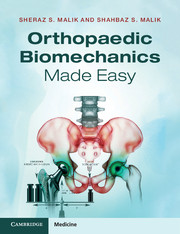Book contents
- Frontmatter
- Dedication
- Contents
- Contributors
- Epigraph
- Preface
- Acknowledgements
- Part I Orthopaedic biomaterials and their properties
- Part II Engineering theory applied to orthopaedics
- Part III Clinical biomechanics
- 6 Biomechanics of the hip and total hip replacement
- 7 Biomechanics of the knee and total knee replacement
- 8 Biomechanics of the shoulder
- 9 Biomechanics of the elbow
- 10 Biomechanics of the spine
- 11 Biomechanics of the ankle and foot
- 12 Biomechanics of fracture fixation
- 13 Trauma meeting: case-based discussions
- Index
8 - Biomechanics of the shoulder
from Part III - Clinical biomechanics
Published online by Cambridge University Press: 05 June 2015
- Frontmatter
- Dedication
- Contents
- Contributors
- Epigraph
- Preface
- Acknowledgements
- Part I Orthopaedic biomaterials and their properties
- Part II Engineering theory applied to orthopaedics
- Part III Clinical biomechanics
- 6 Biomechanics of the hip and total hip replacement
- 7 Biomechanics of the knee and total knee replacement
- 8 Biomechanics of the shoulder
- 9 Biomechanics of the elbow
- 10 Biomechanics of the spine
- 11 Biomechanics of the ankle and foot
- 12 Biomechanics of fracture fixation
- 13 Trauma meeting: case-based discussions
- Index
Summary
Shoulder: functional anatomy I
The shoulder links the upper limb to the trunk. It is a complex of four joints: glenohumeral, acromioclavicular, sternoclavicular and scapulothoracic joints. The glenohumeral joint is the main joint of the shoulder complex, and is usually referred to as the shoulder joint. This chapter considers the biomechanics of the glenohumeral joint.
The glenohumeral joint is a ball and socket joint formed by the articulation of the head of the humerus with the glenoid of scapula.
Geometry and alignment of bones
The humeral head is retroverted 20°–30° with respect to the intercondylar plane of the distal humerus. This provides some restraint to anterior dislocation. The head–shaft angle is 130°–150°. Adjacent to the humeral head are the greater and lesser tuberosities, which are the attachment sites for ligaments and rotator cuff muscles.
The scapula is angled 30° anterior to the coronal plane – this is the ‘plane of the scapula’. The scapula is also superiorly inclined 3°. The glenoid is retroverted 5° from the plane of the scapula and is superiorly inclined 5°. The superior inclination of the glenoid provides some restraint to inferior displacement of the humeral head.
The humeral head is approximately four times the size of the glenoid; this relationship is similar to that of a golf ball on a tee. As the humeral head is not that well ‘covered’ (constraint) by the glenoid, it can have a wide range of motion before structures on the opposite sides of the joint come into contact. As a result, the shoulder joint is the most mobile joint in the body. However, this lack of bony constraints also means that the joint is mainly dependent on other factors for stability. The key factors for shoulder stability are discussed below and in the next section.
- Type
- Chapter
- Information
- Orthopaedic Biomechanics Made Easy , pp. 126 - 135Publisher: Cambridge University PressPrint publication year: 2015



